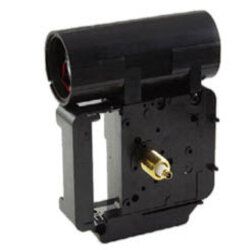Clock Parts
Latest Electronic Clock Movements

Clock movements are the engines, or electric motors, that manage the turning and positioning of the hands for correct time informing. Clock movements were typically mechanical as well as analog, however in modern-day times they are practically solely electronic, and either analog or electronic. In any case, the feature needed boils down to the size of the angle subtended by each hand at every minute.
Clock movements are usually described as motors, and the terms are practically interchangeable. The force behind a mechanical one was either a coiled spring or a hanging weight causing a flywheel to turn. To avoid "freewheeling," or runaway turning, pendulums and also escapement mechanisms were utilized, establishing an oscillation that had actually a specifically acquired frequency.
The modern-day electronic movement acquires its power from a quartz crystal vibrating at a certain frequency that corresponds to the geometry of the crystal. With a voltage drop applied to the crystal, it releases a series of pulses at the resonant frequency. Building up the number of pulses into a digital register monitors the quantity of lapsed time.
This running overall of pulses is a high multiple of the seconds and also minutes required for telling time, so software subdivides the number down to something valuable. The mechanical analog of this process is accomplished utilizing a network of equipments in certain proportions. In both the electronic as well as mechanical technique, the breakthrough of every second creates the used to subtend an additional 6 levels of arc.
Another register builds up seconds right into minutes, and also a third counts minutes right into hours. When the equivalent threshold is crossed, the family member hand is progressed an additional tick. Eventually, each register obtains reset back to zero, developing a total cycle when every little thing begins again once more.
This "ultimately" typically means 12 hrs, yet there's no factor it can't be extended well beyond that. It's practically say goodbye to difficult than establishing a parameter in the motion software application. So, it's simple to increase the cycle to 24-hour (which would require a different dial), yet conveniently offered are electric motors that head out a week or even a month.
These last two expansions require an added hand to indicate the day of the week or the date in the month, respectively. Yet a various type of expansion uses a cycle of 24 hours as well as 50 mins, which represents the duration of the lunar change around the earth. For this reason, it can be utilized to show the existing degree of the trend (if adjusted to your region of the sea).
There are also movements for showing weather sensations, such as temperature level or moisture. Unlike the trend level, which is a routine reappearance like time, such sensations vary within a particular variety, and the worths need to be digitized from sensing unit input. The equivalent dial is adjusted to make sure that the hand rotates through less than one cycle.
Keep in mind that digital clock movements are capable of so much greater than their mechanical counterparts due to the software program aspect. The physical positioning of the hand or hands coincides for both, however the derivation of placement is an order of size extra made complex for the mechanical variation.
Movements display function collections, as well as some attributes we have not also described. Remember that common motors are designed for clocks less than 12-14 inches in size, as their torque limitation can't revolve longer minute hands. It is feasible to construct larger clocks (align to 6 feet throughout!), yet you have to purchase the high-torque version of the motion the attribute collection of which you wish to execute.
Many electric motors operate on batteries (usually AA or C), though other power alternatives are often readily available. You can also discover uniqueness such as pendulums or chimes. There is no end to the enjoyment one can originate from modern-day digital clock movements.
November 29th, 2021